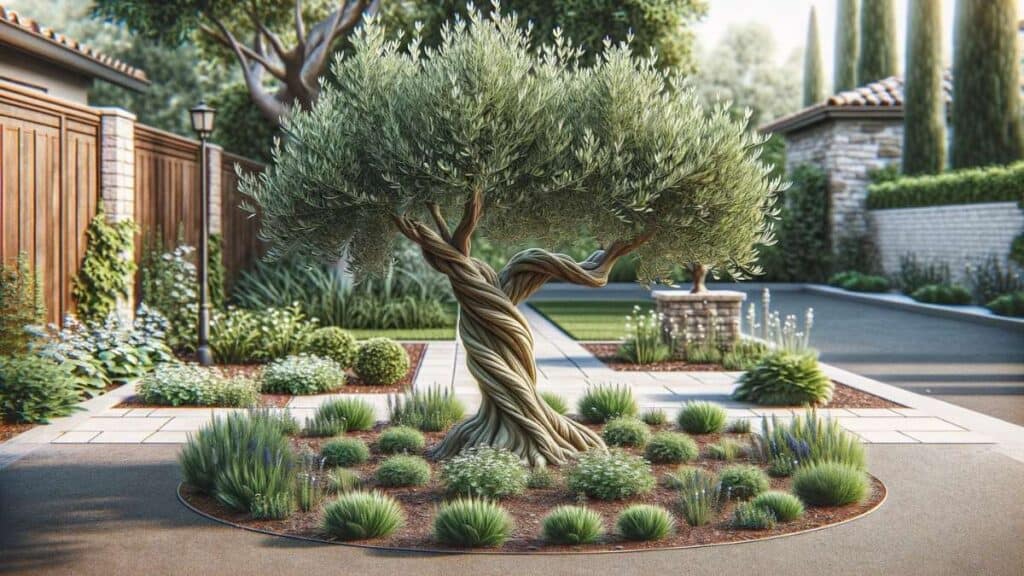Dwarf Olive Trees: Everything You Need To Know
Olive Knowledge is a part of Amazon Associates. As an Amazon Associate, we earn from qualifying purchases. Read our Affiliate Disclosure to learn more.
Dwarf olive trees are an extremely popular choice for all landscape enthusiasts, but also for people who want to improve the design of their home by implementing a few beautiful plants.
In this post, I’ll show you everything you need to know about dwarf olive trees, including varieties, growth stages, fruiting, caring for dwarf olive trees, and much more.
What Are Dwarf Olive Trees?

Dwarf olive trees are hybrid types of olive trees, mostly man-made by grafting different olive tree varieties to get that dwarf form and appearance.
One of the main purposes of dwarf olive trees is indoor olive tree planting for various landscaping and home design purposes.
Aside from size, there aren’t many differences between standard olive trees and dwarf olive trees. All olive tree properties apply to dwarf olive trees, too. So, they can grow in many places; they’re drought tolerant, don’t require too much pruning, etc.
Why Are Small Olive Trees So Popular?
Dwarf olive trees are so popular because of their size and appearance. They are a perfect addition to any home or garden. Mostly, people like to keep them indoors to improve the appearance of their living room, office, or hallway.
Fake olive trees are also extremely popular, but whoever wants a living plant will always choose a live dwarf olive tree instead of something artificial.
Types of Dwarf Olive Trees
There are two main types of dwarf olive trees: fruiting and fruitless olive trees.
Fruiting dwarf olive trees act like any other olive tree, bearing fruits yearly. Even though they’re small in size, they can still produce olives. Of course, you can’t expect to harvest a lot. It’s more for the appearance than for the harvest.
Fruitless dwarf olive trees don’t usually bear fruit, and are a perfect choice for people who don’t want the mess olives create when falling from the tree.
Most Popular Dwarf Olive Tree Varieties
I talked about the most popular olive trees here, where I mentioned the most common variety of dwarf olive trees, which is called “Little Ollie” or “Montra”.
Another extremely popular variety of dwarf olive tree is called “Garden Harvest”. You can check more info about it here.
How Tall Do Dwarf Olive Trees Grow?
Most dwarf olive trees will grow up to 10 feet in height and up to 6 feet in width. However, you’re the one who can keep them even smaller. As always, it depends on the variety. Little Ollie usually grows up to 8 feet, while Garden Harvest may grow even up to 15 feet if not pruned properly.
Some people like to prune dwarf olive trees in a way to keep them as bonsai trees. That way, they can be smaller than 1 foot in height.
Caring For Dwarf Olive Trees
As I already said, caring for dwarf olive trees is almost identical to standard olive trees. However, I’m still going to show you a quick guide on caring for dwarf olive trees. If you want more in-depth answers, check my guide on where olive trees grow best.
Climate Conditions
All types of olive trees prefer Mediterranean-like climate conditions. So, hot summers and mild winters, with plenty of sunny days during the year. Regarding USDA zones, dwarf olive trees will perform best in 8-11 zones.
Dwarf olive trees are pretty drought-resistant but aren’t so resistant to cold weather. So, if you grow them outside, make sure to bring them indoors during colder weather.
Ideal temperatures for dwarf olive trees are between 65° and 80° Fahrenheit (18°C-27°C). However, they’ll keep up with higher temperatures, as well as lower temperatures up to 40° Fahrenheit (4°C). They can even keep up with freezing temperatures, but only for a few days.
Soil Requirements
Dwarf olive trees prefer a mix of sandy-loamy soil that doesn’t drain all the water but also doesn’t keep it near the surface.
If you’re growing dwarf trees indoors, in pots, using a cactus potting mix is a great base. Even better, you can buy a dedicated olive tree potting soil on Amazon (check above).
Water Requirements
While dwarf olive trees are still young, you’ll have to water them twice a week during the summer and once every two weeks during the winter period.
Once they grow up (+3 years of age), you can reduce the watering schedule and irrigate them twice a month during summer and once a month during the winter period. They’ll gather enough water through the rains.
If you’re growing dwarf olive trees indoors, once they’re grown up, water them once every two weeks, regardless of the season.
Pruning
Pruning dwarf olive trees is pretty straightforward unless you want to create some specific bush type. Make sure to always prune dwarf olive trees in late winter or early spring.
Quick guidelines you should follow when pruning dwarf olive trees:
- Remove branches too close to the soil and ones that grow along the trunk
- Cut branches that don’t grow horizontally.
- Cut branches that grow towards the inside to make the tree center free. That way, the trunk will be able to absorb more sunlight.
Just make sure that you have the right pruning equipment since the whole job will be much easier, and you’ll reduce the chances of messing something up.
Fertilizing Dwarf Olive Trees
If you want to get the most out of dwarf olive trees, you should fertilize them regularly. Fertilizers will enrich the soil with the most important nutrients for an ideal olive tree growth.
I suggest you use some high-quality fertilizers (organic if possible), and fertilize them twice a year. Once during the spring and once in mid-summer. Also, it’s important to follow instructions on fertilizer packaging since each fertilizer may require different amounts applied to the soil.
If you don’t know how to fertilize olive trees properly, I recently made a quick fertilizing guide, so make sure to check it out.
Growing Mini Olive Trees In Containers or Pots
Dwarf olive trees are an ideal plant to grow inside pots or containers. They’re pretty tolerant and stay healthy if you follow the rest of the guidelines above. Just make sure to repot them when needed.
Actually, most people who grow dwarf olive trees grow them inside pots.
Where To Buy Dwarf Olive Trees?
There are three best places I recommend to you when it comes to buying dwarf olive trees:
They all provide you with healthy olive trees that’ll last for years. I’m sure there are many other sites out there, but these two are popular and trusted by many people.

